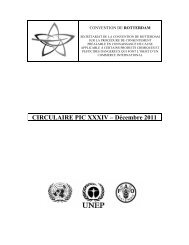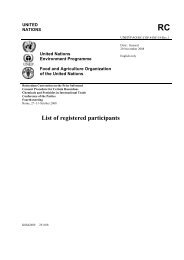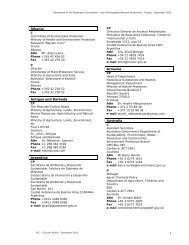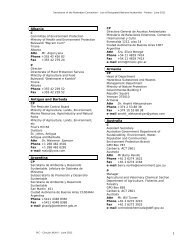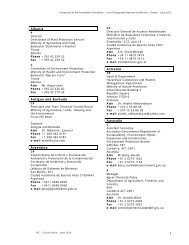RC - What is RC? - Rotterdam Convention
RC - What is RC? - Rotterdam Convention
RC - What is RC? - Rotterdam Convention
Create successful ePaper yourself
Turn your PDF publications into a flip-book with our unique Google optimized e-Paper software.
2. R<strong>is</strong>k Evaluation<br />
a) Key findings of the national r<strong>is</strong>k evaluation<br />
Hexachlorobutadiene <strong>is</strong> placed in the category of Class I Specified Chemical Substances based on the<br />
following judgment.<br />
1. Biodegradation: Based on the report of the biodegradation test with microorgan<strong>is</strong>ms, the percentage of<br />
biodegradation <strong>is</strong> 6, 32, 33% and 5, 11, 7%, measured by BOD and by GC, respectively. Thereafter,<br />
Hexachlorobutadiene <strong>is</strong> considered to be very pers<strong>is</strong>tent.<br />
2. Bioaccumulation: Based on the report that BCF for f<strong>is</strong>h exposed <strong>is</strong> 6,280 (high exposure level case)<br />
and 7,720 (low exposure level case), Hexachlorobutadiene <strong>is</strong> considered to be very bio-accumulative.<br />
3. Long-term toxicity: H<strong>is</strong>tological renal abnormalities were observed in rats at 2 mg/kg/day of<br />
Hexachlorobutadiene and higher in an approximately two-year study. When they were admin<strong>is</strong>tered at 20<br />
mg/kg/day, renal tubular adenoma and adenocarcinoma were observed. A reproductive toxicity study on<br />
rats suggests that Hexachlorobutadiene decreases the weights of pups at 7.5 mg/kg/day and higher. The<br />
same study also indicates that the chemical decreases the conception rate and inhibits implantation at 75<br />
mg/kg/day.<br />
b) Key data reviews consulted and a brief description<br />
Biodegradation and Bioaccumulation data<br />
http://www.safe.nite.go.jp/data/hazkizon/pk_e_kizon_d<strong>is</strong>p.html?k_no=1637<br />
c) Reference to national studies, eg toxicological and ecotoxicity studies<br />
No information.<br />
d) Summary of actual (potential) human exposure and/or environmental fate<br />
Hexachlorobuta-1,3-diene in water and sediment was measured in 1981, but it was not detected in any<br />
point. (limit of detection; water…0.02 ug/l, sediment…0.002~2 ug/g-dry)<br />
3. R<strong>is</strong>k Reduction and Relevance to Other States<br />
a) Estimates of the quantity of chemicals used, or imported/exported at the time of the regulatory<br />
action and if possible information on ongoing trade<br />
It was reported that there were neither manufacturing nor import in 2002.<br />
b) Relevance to other States i.e. those with similar conditions of use<br />
No information.<br />
c) Comments on the typical use of the chemical within the notifying country, with comments on<br />
possible m<strong>is</strong>use (if appropriate)<br />
No information.<br />
2



